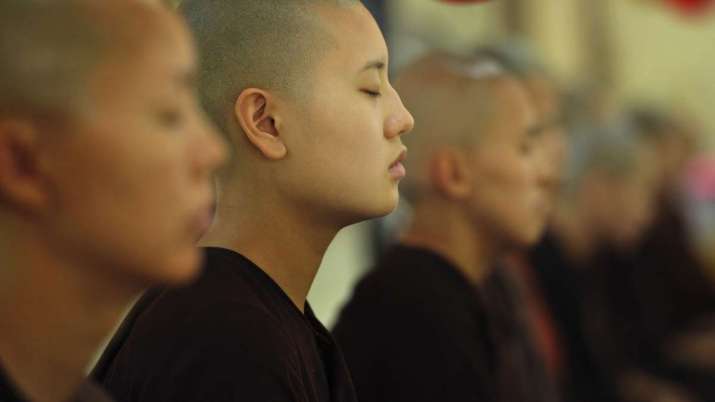
Besides mindfulness of breathing, there are further forms of meditative mindfulness.
The Buddha recommended, for example, concentrating on the four postures of the body, walking, standing, sitting, and lying, concentrating mindfully on the actions until the disciple realizes that there is no real self who walks, stands, sits, and so on.
Similarly, the Buddha recommended mindfulness of actions such as bending and stretching, eating, drinking, chewing, tasting, discharging excrement and urine, and other bodily functions, to give the disciple a clear conception that an action of the body is an impersonal process devoid of an actual ego-entity.
Another exercise is contemplation on the loathsomeness of the body, from the top of the hair to the tip of the toes, the sack of skin stretched over the frame, filled with impurities: sinews, marrow, kidneys, heart, liver, diaphragm, spleen, lungs, stomach, bowels, excrement, bile, phlegm, pus, blood, sweat, lymph, tears, skin oils, saliva, mucus, urine, and so on. The purpose of this meditation is freedom from the illusion of the attractiveness of the human body by concentration on its opposite. It helps to counter infatuation with the body and sexual desire.
A similar exercise is to imagine the parts of the body the way a butcher might slaughter and prepare a cow into separate portions, until you no longer see it as a unified body but just as so many fleshy parts. You must dissect the body mentally until you no longer see it as a material entity with existence of its own, when it is indeed nothing more than a compilation of the four elements of solid, gas, heat, and liquid.
Another way is cemetery meditations, which help the disciple overcome the idea that he is never going to die. Imagine your corpse cast into a charnel ground, one, two or three days dead, swollen, blue-black in color, and full of corruption and decay, until you ultimately realize you are free of the delusion of infallibility.
Although such exercises sound grotesque, their purpose is not to develop aversion, but rather to explode false illusions which keep a tenacious hold on the mind.
Once contemplation of the body begins to take effect, the result is positive. The disciple will develop mastery over discontent, anxiety, exposure, deprivation, slanderous attacks, and even physical pain. He will be able to develop the four absorptions (Pali: jhana), which purify the mind and bestow happiness. (Nynanatiloka 67)
The second of the four foundations of mindfulness is contemplation of feeling.
The Buddha said: “In experiencing feelings” the disciple knows: “I have an agreeable feeling,” or “I have a painful feeling” or “I have an indifferent feeling . . .” (Digha Nikaya 22)
Thus, he dwells in contemplation of the feelings, either with regard to his own person, or to other persons, or to both. He beholds how feelings arise. He beholds how they pass away.
The word “feeling” here means how the mind is disposed when it encounters an object of experience. When a pleasant feeling arises, it may have its origin in greed or desire. An unpleasant feeling may arise out of fear, hate, or aversion. Neutral feelings may arise out of delusion or ignorance.
The secret to this meditation exercise is to look at experience and cut off the root of unwholesome volition as it is beginning to arise and interact in feeling. If we just let the mind play, in an uncontrolled manner, defilements can exert a role in coloring experience. If, however, through mindfulness, we watch an experience as it is arising and passing away, we can catch unwanted kamma and defuse any attachment, aversion, or indifference. Through mindfulness, we can turn the experience back into a bare mental event, shorn of subjective interplay.
The trick is to learn to let the flow of events arise, dissolve, and disappear without being subjectively involved. Once the impure root of feeling loses its hold on events, events lose their illusory sense of permanence and become part of the impermanent flux of the stream of events. With subjective feeling thus suppressed in connection with observation, there is no longer any sense of a permanent ego interacting with events. This is what non-involvement means. It is the detachment necessary for right mindfulness.
If we just let the mind play in an uncontrolled manner, the defilements will exert a role in coloring experience. If, however, through mindfulness, we watch an experience as it is arising and as it passing away, we may catch unwanted kamma and defuse any attachment to aversion or indifference. Through mindfulness, we can turn the experience back into a bare mental event, shorn of subjective interplay.
The secret is to learn to let the flow of events arise and dissolve, without being subjectively involved. When the unwholesome root of feeling loses its hold on events, events lose their illusory sense of permanence and become part of the impermanent flux of the stream of events. With subjective feeling thus suppressed in connection with observation, there is no sense of a permanent ego interacting with events. This is what non-involvement means. It is the detachment necessary for right mindfulness.
The third of the four foundations of mindfulness is contemplation of the mind. The Buddha said:
Herein the disciple knows the greedy mind as greedy; knows the hating mind as hating, and the not-hating mind as not-hating; knows the deluded mind as deluded, and the undeluded mind as undeluded. He knows the cramped mind as cramped, and the scattered mind as scattered; knows the developed mind as developed and the undeveloped mind as undeveloped; knows the surpassable mind as surpassable, and the unsurpassable mind as unsurpassable; knows the concentrated mind as concentrated, and the unconcentrated mind as unconcentrated; knows the freed mind as freed, and the unfreed mind as unfreed. (Bodhi 99)
The word “mind” here means consciousness and should not be confused with “thinking,” which would necessitate verbalization and/or discursive thinking. Mind is a sequence of momentary mental acts as opposed to being an enduring separable entity. Neither is it connected to a sense of self nor belonging to a self. Mind is a bare state of consciousness free of subjective association.
As meditation practice deepens, the sense of the “observer” becomes more and more detached and then there is more and more of a sense of detachment until a detached mind is all there is.
As this happens, the unwholesome roots of greed, aversion, and delusion become less and less capable of interacting in consciousness, and it becomes less-cramped and scattered and more-developed, concentrated, and free. The mind becomes more and more pure.
As contemplation deepens, the contents of the mind become increasingly rarefied. Irrelevant flights of thought, imagination, and emotion subside, mindfulness becomes clearer, the mind remains intently aware, watching its own process of becoming. . . . The mind itself—the seeming solid, stable mind—dissolves into a stream of “cittas” flashing in and out of being, moment-by-moment, coming from nowhere and going nowhere, yet continuing in sequence without pause. (Bodhi 100).
References
Bodhi, Bhikkhu. 1984. The Noble Eightfold Path: The Way to End Suffering. Kandy: Buddhist Publication Society.
Nyanaponika, Mahathera. 1983. The Heart of Buddhist Meditation. London: Rider Press.
Nyanatiloka, Mahathera. 1967. The Word of the Buddha. Kandy: Buddhist Publication Society.
Related features from Buddhistdoor Global












